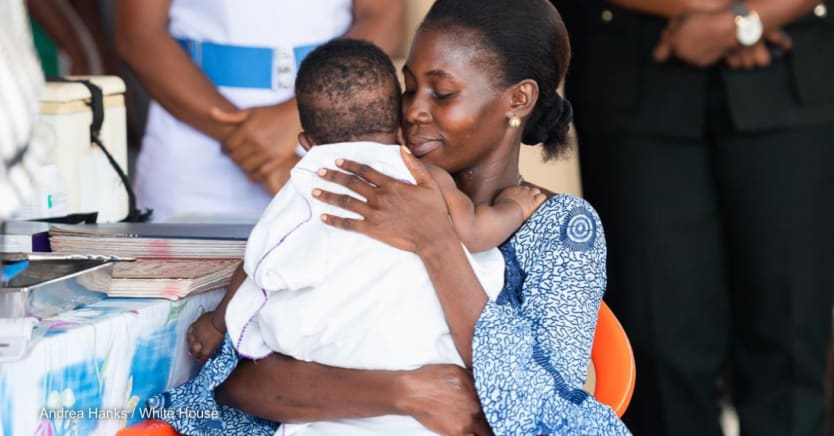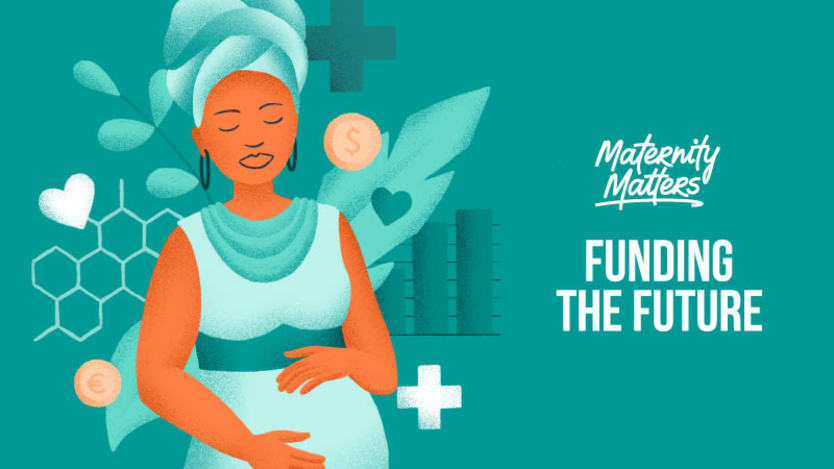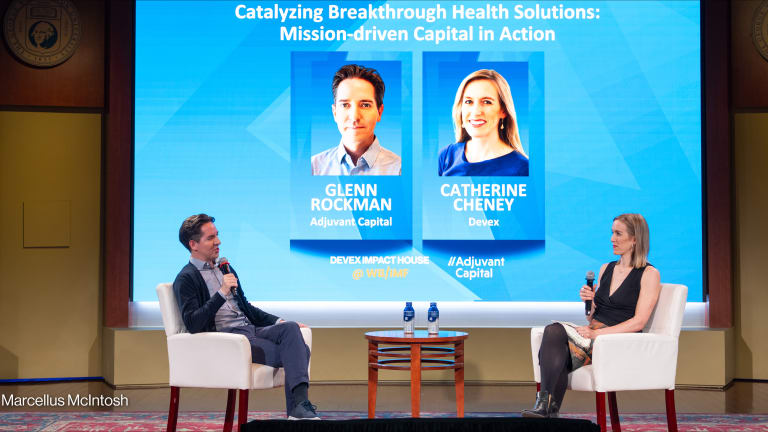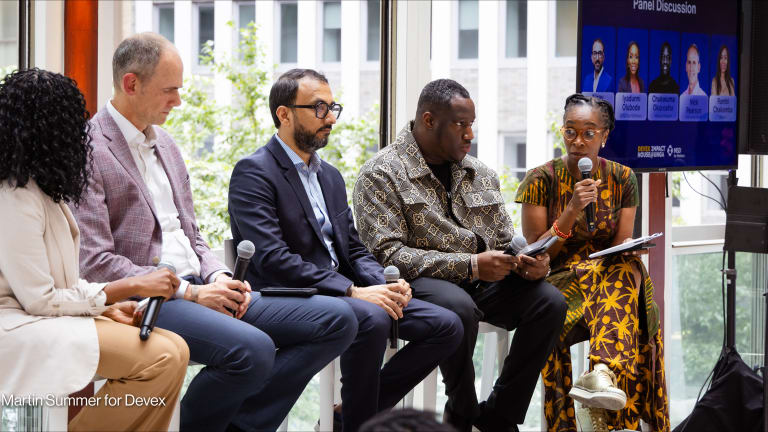
“We need to change the way we invest and we need new players at the table with new approaches to complement what’s been done in the past decade [in reproductive, maternal, newborn, child, and adolescent health],” said Annie Thériault, chief investment officer at Grand Challenges Canada. The organization is an innovation funder that supports both nonprofit and for-profit organizations in developing and transitioning to scale solutions to health and development challenges in low- and middle-income countries, as well as domestically in Canada.
Last year, in a conversation with Devex, Thériault — who also oversees the Every Woman Every Child Innovation Marketplace at GCC — urged more players to provide early-stage capital for social entrepreneurs specifically within maternal health. This year she said some capital is going toward social enterprises, but the maternal health space is “not seeing [the] floodgates being opened.” That, she said, needs to change.
Over 800 women die a day from preventable causes related to pregnancy and childbirth. COVID-19 has only exacerbated the issue, putting increased strain on already weak health systems and making it hard to uphold basic services such as maternal health and family planning.
With overseas development assistance also under threat following the economic strain imposed by the pandemic, engaging the private sector is critical to moving the needle to improve reproductive, maternal, neonatal, child, and adolescent health, or RMNCAH, Theriault said.
There are technologies available today that ... really have the opportunity to revolutionize the quality of care in emerging markets in LMICs as well as in high-income markets.
— Annie Thériault, chief investment officer, Grand Challenges Canada“Private investors through the crisis have had [a] strong performance and … not necessarily suffered as much. That capital is potentially available to invest in new investment vehicles and new social enterprises, but there needs to be a little bit of “pixie dust,” a little bit of catalytic capital from government players to capitalize those vehicles to be launched,” she said.
Having spoken with Devex last year, Thériault explained what kinds of vehicles could be the most impactful, why it’s important to invest in early-stage social enterprises, and how the pandemic has changed the funding landscape for such entities.
This conversation has been edited for length and clarity.
Over the past year, what has changed in respect to how GCC leverages private-sector capacity for RMNCAH impact?
Since last year, our funding with Global Affairs Canada was renewed and so now we have a seven-year grant agreement with them to continue our work. With this, we’re able to include equity as one of the vehicles that we use to fund companies, whereas in the past five years that wasn’t something that was necessarily on the table. It doesn’t mean that we look to do [financial] equity for everything, it’s really a tool that we wish to use when it’s appropriate. Our capital is going to grow the organization alongside other investors when the activities we fund are growth-oriented, as opposed to often providing grants to private companies for all of their activities.
The purpose of the grants is typically for activities that are not return-driven, but at this point, we have the flexibility to also make equity investments, which was something we had done in the earlier days of GCC, but not in the last five years. We’ve always been able to do loans and will continue to also use this tool to support companies and nonprofits that can generate sufficient cash flow to cover loans. All of our financial instruments apply across all of our portfolio, not just our RMNCAH portfolio.
The other piece is, if all goes well, we should be able to launch our women, children, and adolescent health fund in the fall. This is something that’s been in the works for over two years and we’re pretty excited about it because it’s one of the few vehicles out there that has the women, child, and adolescent health mandate broadly, not just the maternal health care piece, not just the reproductive health care piece, but the whole health of the woman, the child, and the adolescent. It is a unique approach in the environment and so hopefully we’ll pull it off. The challenge with this type of vehicle is finding the early movers to join the initial launch as there are more followers in the impact investment space.
Last time we spoke you urged more players to provide early-stage capital for social entrepreneurs, specifically within maternal health. Have you seen that happen at all?
What I’m seeing is a lot of new investment firms, particularly women-led investment firms, having a strong interest in health. In a purpose-driven way, it’s really improved women, child, adolescent, and maternal health.
I’m seeing a lot of new investment vehicles trying to be launched by talented teams and long fundraising cycles. [Engaging] the private sector is critical to moving the needle because when we look at official development assistance, that is not increasing and so the only way to add money for RMNCAH is by getting investment from the private sector. European countries, North American countries, every rich country out there has had to overspend to deal with COVID-19 and so ODA [official development assistance] capital is definitely at risk.
At the same time, what we’re seeing is a hunger from many emerging markets in seeing new technology coming through. COVID-19 has opened their eyes — not that they weren’t seeing it before — but really put it in their face, and in a very serious way. When we see vaccination rates [of those who received at least one dose] in Canada at 80%-plus and certain emerging markets, 1, 2, 3, 4, 5%, I think that has made people in emerging markets realize, “Hey, we’re not at the table. Why is that happening? We should access better technologies.” So, there’s a demand side being created. There are enterprises that are ready to solve these problems, there’s investment funds that are there when there is enough investment interest from the private sector, but that piece is not there. We’re seeing a gap; we’re seeing donors shying away or trying to do it their own way rather than supporting a new industry.
Going forward, what is GCC’s level of private sector investment in RMNCAH likely to be?
Private sector engagement
As defined by the Organisation for Economic Co-operation and Development, this is an activity that aims to engage the private sector for development results, which involve the active participation of the private sector.
The definition is deliberately broad in order to capture all modalities for engaging the private sector in development cooperation, from informal collaborations to more formalized partnerships.
Read more about the definition and how Maternity Matters: Funding the Future is exploring the topic.
We’ve always hovered in the 20-30% participation with the private sector, either investing ourselves with a private sector vehicle or grant combined with private sector investors. I don’t really see that changing. For us, it’s very much about staying the course. The expertise of GCC is really in the grant management space and we can work strategically for large donors or use our normal processes of sourcing against GCC. And so, we’re definitely in a mode of wanting to engage with other donors that are looking to perhaps partner in some way.
Perhaps, I would say, we’re going to have a strong emphasis on women-led initiatives, locally led initiatives, and really just continue to focus on the best projects and ventures that can address those priorities.
With respect to private sector engagement, what I’d like to see happen right now, not in five years, is more players like the DFIs [development finance institutions] and others come to the table and back new investment vehicles, whether it’s ours or the dozens of others that I’m aware of that are all over the world, whether they are from high-income markets or low- and middle-income markets because these priorities are common — maternal and child issues.
There are technologies available today that ... really have the opportunity to revolutionize the quality of care in emerging markets in LMICs as well as in high-income markets … I’d like to see money move toward those new investment vehicles, not in a self-serving way. I just strongly believe that the technologies are out there and with the right investors, with impact mandates at the table, it can really prevent those market failures that we’ve seen for the past decades.
The Funding the Future series is supported by funding from MSD, through its MSD for Mothers program and is the sole responsibility of the authors. MSD for Mothers is an initiative of Merck & Co., Inc., Kenilworth, NJ, U.S.A.









